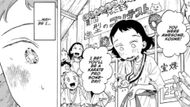On August 17, 2025, Taizan 5 surprised everyone by releasing Fighting Girls, a 73-page one-shot published through Shonen Jump+, MangaPlus, and Viz Media. At first glance, Fighting Girls appears to be a straightforward martial arts manga.
Although when a new work from Taizan 5 drops, readers tend to brace themselves. The author of Takopi’s Original Sin and The Ichinose Family’s Deadly Sins has developed a reputation for weaving emotionally devastating stories about childhood trauma, broken families, and impossible dilemmas.
At its core, Fighting Girls follows Koume, a girl fascinated by MMA who decides to train in karate. For a while, she thrives, becoming the ace of her team and brimming with confidence, until Tiara arrives. From the moment Tiara steps into the dojo, she outshines Koume in every way. No matter how hard Koume trains, Tiara always seems a step ahead. What begins as an initial frustration slowly evolves into a lifelong rivalry.

Then comes the twist in perspective: Tiara’s story. Taizan 5 has always excelled at shifting points of view, and here, the narrative device works beautifully. From Tiara’s side, we discover the truth: She isn’t cold out of arrogance but as a survival mechanism.
Born into a deeply patriarchal household where all attention and resources are funneled toward her brothers, Tiara grows up neglected and dismissed. Her parents see her as little more than a spare child, burdening her with chores while investing their hopes in her siblings. To cope, Tiara shuts off her emotions, using karate as her only outlet.
This dual narrative transforms Tiara from an “untouchable wall” into someone who is deeply human. Koume and Tiara are not opposites but mirrors of each other, two girls escaping broken homes through martial arts. Their rivalry, rather than dividing them, becomes the closest thing they have to companionship.
Disclaimer: This article contains the writer's opinion. Readers’ discretion is advised.
Taizan 5’s signature themes, reimagined

One of the most fascinating aspects of Fighting Girls is the way it blends Taizan 5’s recurring themes with a lighter tone. Dysfunctional families? Check. Children forced to navigate emotional neglect? Check. But instead of spiraling toward tragedy, the narrative uses these elements to frame resilience.
This makes me wonder if Taizan 5 intentionally wanted to challenge his reputation. After the heavy darkness of Takopi and Ichinose, perhaps he wanted to prove that he could tell a story of pain without leaving readers devastated.
Fighting Girls feels like an experiment, a way of asking whether readers can still connect deeply with characters when the ending is hopeful rather than catastrophic. I think he succeeded.
Visuals and pacing in Fighting Girls manga

The artwork in Fighting Girls deserves recognition, too. Taizan 5 has a knack for clean, expressive paneling. The fight sequences are dynamic yet easy to follow, capturing the raw intensity of martial arts.
The pacing is another strength. For a 70-page one-shot, Fighting Girls manages to cover a surprising amount of ground without feeling rushed. We see both protagonists’ backstories, multiple matches, and a satisfying conclusion, all within a tight structure. It is a testament to Taizan 5’s ability to balance storytelling economy with emotional depth.
A refreshing change of tone

As someone who has read Takopi’s Original Sin and The Ichinose Family’s Deadly Sins, I couldn’t shake off the expectation that Fighting Girls would end in tragedy. I was mentally preparing for one of three scenarios: Koume succumbing to jealousy and harming Tiara, Tiara being crushed by her family’s toxicity, or both rivals burning out before achieving their dreams.
In my opinion, Fighting Girls is one of Taizan 5’s most refreshing works precisely because it doesn’t try to devastate the reader. Instead, it chooses sincerity over shock value. The narrative doesn’t rely on despair to make its point; it relies on the quiet power of acknowledgment and support.
Did it blow me away like Takopi? Not exactly. This one-shot manga doesn’t carry the same groundbreaking punch or social commentary. But it doesn’t need to. It succeeds on its own terms, as a wholesome yet realistic portrayal of two girls finding strength in rivalry.
